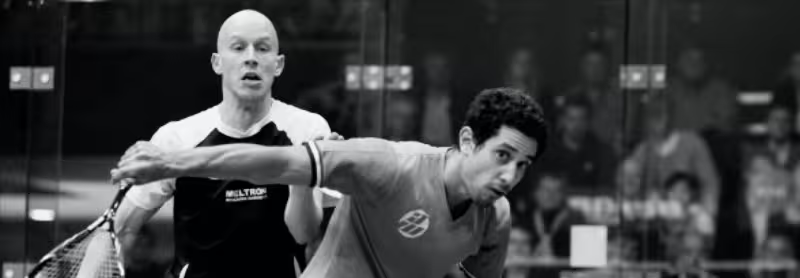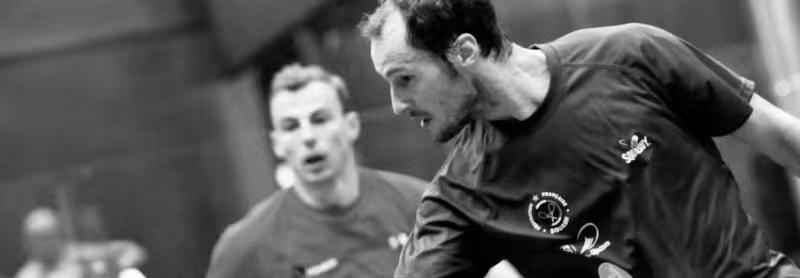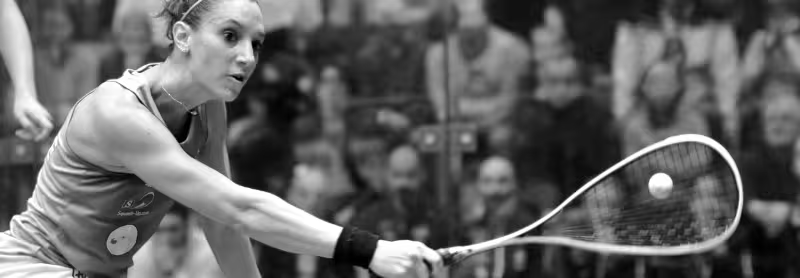Last Updated: 09 May 2024 / 6-Min Read / Translate
TL;DR
As I was performing a video analysis for one of my pupils this week, I was reminded of the difficulty some club players have with a red dot squash ball. Specifically, how they found it too bouncy. It's an interesting phenomenon and one that makes for a perfect short article.

Both these players are masters at controlling a hot squash ball.
Personally, I find the blue dot squash ball too bouncy for beginners, at least when I am on court feeding them. The bounce needs to be high enough that it recreates a warm single yellow dot and I believe a red dot does that. If it bounces too high, then that creates confusion for new players because the other balls don't bounce as high. I'm not saying that there is no need for a blue dot, but unless the court is very cold or the players miss more shots than they hit, I feel a red dot is better for their development.
Becoming accustomed to a ball that bounces the same as other hot balls is key. Using the wrong ball or a cold ball that never gets warm ruins the experience of playing squash for new players. New players rarely hit lots of shots without mistakes and they don't hit the ball cleanly, but they do need the opportunity to try. I keep saying that you should use the ball that makes squash the most fun, and generally that is a bouncy ball. if you can't get a single yellow or double yellow dot hot, then use a red.
It's also worth reminding you that it is okay to use a red dot squash ball for some practices, drills and games and then use a single yellow dot for others. It's okay to switch between balls for different situations.

Gaultier is a man of total commitment.
So now it gets a little more interesting. The first issue I have often run into is one of snobbery. As a club player gets a little more confident and improve their ability, the idea of going "back" to a red dot seems like a backward step. Notice how I said "back" with quotations marks. Here lies the issue. We are always taught that the best players use double yellow dots and therefore everybody should aim to play with one all the time. Anything less is an acceptance of weakness or lack of skill and strength.
This attitude holds players back because their insistence on using the wrong ball delays their improvement. If I can get club players to accept that using a different ball from a double yellow is NOT a backward step, then they now have an opportunity to develop skills that require very bouncy balls.
The second issue is related to technique. I have often found club players can't control a red dot. They hit it too hard. They don't make adjustments to the swing speed or aim. They quickly complain that it's too bouncy. As you get better and better at squash, the double yellow ball is incredibly bouncy once it is very hot.
Being able to adjust the swing speed and control where the ball bounces is a key skill that is required to move from "club player" to "advanced player". I have found that if a player can't swing well with a red dot ball, they they are often using power rather than control. At the beginning of my coaching career, I was taught that if a player can't swing slowly with control, then they don't really have a good swing. I believe that to be true, perhaps even more so with lighter rackets.
So if you are a club player reading this I urge you to spend some time on court with a red dot and become accustomed to its bounce and flight characteristics as they are quite similar to a very hot double yellow. Try to feel confident adjustment your swing speed and aim to get the ball controlled required to win matches on hot courts.

Almost perfectly in the centre of the squash racket!
Here we are, at the "top" of the squash ladder. Calling ourselves advanced players. Able to hit crosscourt volley nicks and trick shots. Rally up and down the wall until our opponent is bored. Why would we every need to use a red dot? Two minutes hitting the ball hard and it's hot to the touch. No need for a red dot, right? Right. No "need", but it can make life a little easier.
Most advanced players have lost their ball snobbery. They understand that using the right tool for the right situation is more important than simply only ever using a double yellow dot squash ball. Sometimes it's nice to be forced to have to adapt to something we don't like or feel comfortable with. Sometimes it's helpful to use a red dot so that we can practice holds, tricks, drops, and other shots that don't keep the ball hot.
I am a great believer in lots of mini-sets of drills, often with a hard-hitting drill followed by something softer. But that style of drill is not always needed. A good example is that I like to finish all solo drills sessions with a technical cool down and serves fit that requirement perfectly. Using a red dot is the ideal ball for this. It stays the same bounciness all the time without having to heat it up. Using a double yellow dot would mean you only do 10 or so serves before you notice it getting colder. That's not enough serves to really benefit from the drill.
Don't let ball snobbery get in the way of your development. A red dot squash ball is great for learning to adapt to very bouncy balls or hot courts. If you can't control the ball, then maybe, just maybe, your swing is not as technically solid as you think it is.
Use a red dot squash ball in your training at least twice per month - even if it is only for practicing your serve.